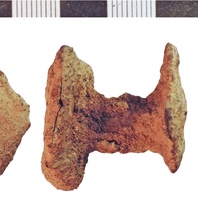
Viking Objects
Clench Nail (NLM-2FC690)
Clench nails were used in clinker-style ship-building from the 7th century to the 15th and also for domestic purposes, in which clench nails might appear where ship timber has been reused. Clinker ship-building involved building the ship’s hull first out of layered planks attached to the keel and held together using clench nails. Clinker-built boats and ships are particularly associated with the Vikings.
Read More
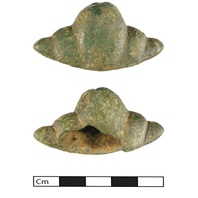
Viking Objects
Sword Pommel (NARC-E7AAF4)
An Anglo-Scandinavian copper-alloy sword pommel classed as a Petersen L type VI. The design is a fusion of Anglo-Scandinavian and Anglo-Saxon fashions. In many cases the design of the sword pommel is the only method of identifying the possible type and date of the sword it was attached to.
Read More
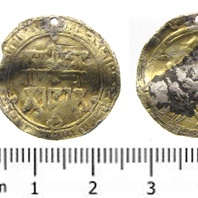
Viking Objects
Samanid Silver Dirham Pendant (LCNCC:2014.16)
An Arabic silver dirham minted c. 905-906 (Hijra 293) for the Samanid ruler, Isma’il ibn Ahmad (849-907), that has subsequently been pierced and gilded so that it could be worn as a pendant. It was probably minted in Balkh, Afghanistan. The Vikings often repurposed items like this. The dirham was a unit of weight used across North Africa, the Middle East, and Persia, with varying values which also referred to the type of coins used in the Middle East during the Viking Age. These coins were extremely prized possessions not only for their silver value but as a way of displaying one’s wealth and vast trade connections. Millions of Arabic dirhams would have been imported throughout the Viking world and are mostly found in hoards.
Read More
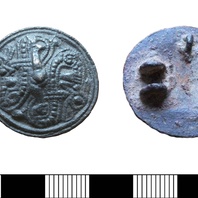
Viking Objects
Jellinge-Style Disc Brooch (LIN-F00E1B)
This Viking cast copper-alloy disc brooch is decorated with a Jellinge-style moulded zoomorphic motif comprising a knot of beaded lines. Brooches of this type are widespread in Scandinavia, with a particular concentration at Birka, the trading and military site in Sweden. For more information on Scandinavian jewellery in England check out our blog: Brooches, Pendants and Pins: Scandinavian Dress Accessories in England.
Read More
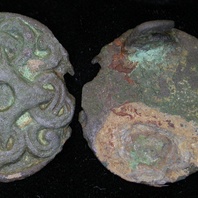
Viking Objects
Copper-Alloy Disc Brooch (LEIC-782CD2)
This Anglo-Scandinavian copper-alloy disc brooch has small traces of silvering on both surfaces. It is decorated in Borre-style interlaced knotwork matching the East Anglian type II. For more information on Scandinavian jewellery in England check out our blog: Brooches, Pendants and Pins: Scandinavian Dress Accessories in England.
Read More

Viking Objects
Zoomorphic Strap-End (SWYOR-B89D43)
This Thomas Type A strap-end is decorated with zoomorphic designs and what seems to be a face which may fall into the Trewhiddle style. There is some trace evidence of silver plating. Strap-ends came in various styles and were fairly common throughout the Viking world. They were used to decorate the ends of belts and to stop them getting damaged.
Read More
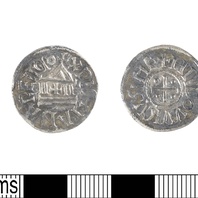
Viking Objects
Carolingian Denier (LIN-F6C6E1)
A Carolingian silver denier issued by Louis the Pious and classified as a Christiana Religio type, which was his third and last coinage. It is possible that it made its way to England prior to Viking incursions but it is equally likely that the Vikings brought this coin with them as plunder after raiding in Frankia.
Read More
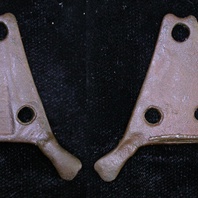
Viking Objects
Stirrup Mount (LEIC-AF8883)
This copper-alloy stirrup-strap mount is decorated with an unusual geometric pattern with incised lines running across its surface. It has been classified as a Williams Class A Type 8, but is probably a hybrid.
Read More
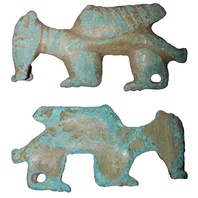
Viking Objects
Scabbard Fitting (LIN-3DE8C7)
This chape, proabably meant for a knife scabbard, has an openwork abstract zoomorphic form representing a winged beast in profile.
Read More
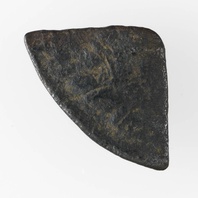
Viking Objects
Unprovenanced Abbasid Silver Dirham (CM_1777_2008)
It is unknown for which ruler this dirham was minted nor where the mint was located. However, it has been speculated that the mint would have been located somewhere in Iraq, Iran, or Central Asia. The dirham was a unit of weight used across North Africa, the Middle East, and Persia, with varying values which also referred to the type of coins used in the Middle East during the Viking Age. These coins were extremely prized possessions not only for their silver value but as a way of displaying one’s wealth and vast trade connections. Millions of Arabic dirhams would have been imported throughout the Viking world and are mostly found in hoards. It is thought that one cause of the Viking Age was a reduction in access to Arabic silver.
Read More
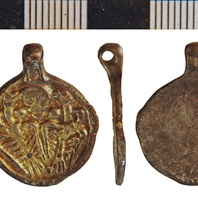
Viking Objects
Pendant with an Odin Motif (NLM-7F954A)
A cast silver, gilded pendant featuring an image which has been interpreted as representing the one-eyed god Odin and his two ravens Huginn and Muninn. There are a number of close parallels which establish the wide currency of this subject group. These include numerous examples from Russia and two from Sweden, including some with silver gilding. A silver pendant with a related, but distinct design is known from Sjælland, Denmark. With some exceptions, pendants were generally worn by women as part of their Scandinavian dress.
